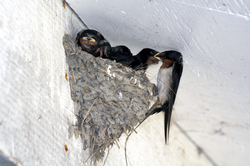
by Alex A. Kecskes
Tired of swallows building mud nests in the corners of your front porch? Had it with birds nesting in attics, eaves, vents and awnings? Fed up with trying to wash bird nests and their droppings off your walkways, lawn furniture, BBQ and cars? And even after you do, the stains remain! You’re not alone. Thousands of property owners across the country face the same dilemma.
Birds generally build nests that are inaccessible, hidden, or camouflaged. Though in some cases, birds will build nests on top of chimneys. They like the heat produced by chimneys. Other birds are drawn to a chimney’s cavity shape, which they find ideal for nesting.
If you have a flat “under-hang” over your porch, it makes an ideal sheltered spot for birds to nest, and it can be nearly impossible to get rid of birds once they settle in. No matter how many times you knock down their nests, they’ll come back.
There are lethal ways to keep pest birds from nesting on your property. But you should be warned that the Migratory Bird Treaty and Endangered Species acts prohibit the trapping, possession, or killing of most birds, their eggs and nests without a permit. Only house sparrows, starlings and pigeons are unprotected by state or federal law; however, local ordinances may still protect these birds. So check with local authorities before you take action against birds or their nests.
Your other alternative is to use humane and non-lethal bird deterrents to discourage nesting. One property owner hung a series of small mirrors under the eaves of his home where pest birds often chose to nest. When birds came to build a nest, they saw their reflection, got tricked into thinking another bird had already claimed the space, and moved on. Of course, there are other equally effective bird deterrents if you don’t fancy covering your house with mirrors.
To keep swallows, starlings, pigeons, seagulls and other pest birds from nesting on ledges, eaves, beams and similar areas, there's the Bird Slope. Birds slip and slide right off these angled, slippery PVC panels. And if they can’t get a foothold, they soon get frustrated and leave. The best bird slopes are U.V. protected to stand up to extended periods of weathering and sunlight. They’re easily mounted on the underside of eaves with special mounting clips. Some bird slope panels have a "snap-on" extender to streamline installation on wider ledges and coverage areas. Mounting clips are also available for vertical installation on the sides of buildings. You should use the “end caps” provided by some manufacturers to keep birds from getting behind the sloped panels. Architects like to use these sloped panels because they are less visually obvious that other bird deterrents, and because they come in stone and grey colors to better blend in with a building’s color scheme.
To discourage pest birds from building nests atop chimneys, install stainless steel bird spikes. They prevent birds from landing. And if they can’t land, they can’t build a nest. The spikes come in 3-, 5- and 8-inch widths. They’re easy to install and you’ll typically only need a single strip of spikes to cover your entire chimney.
To keep birds from building nests on patio covers, awnings, gazebos and other flat surfaces, some homeowners have had considerable success with Bird Spiders. These versatile bird-proofing devices feature stainless steel “arms” that whip around in the breeze. No bird in her right mind would build a nest near such a threatening display. Spiders come in various sizes--usually 2-, 4-, 6- and 8-foot designs to provide increasingly wider diameters of deterrence. Spiders do a nice job in discouraging pigeons, seagulls, and larger birds. They are easy to install and move, and there’s nothing to replace or maintain once they’re up. The best spiders will feature a U.V.-protected polycarbonate base and come standard with a glue-on base, allowing them to be glued down permanently to flat most surfaces.

 RSS Feed
RSS Feed